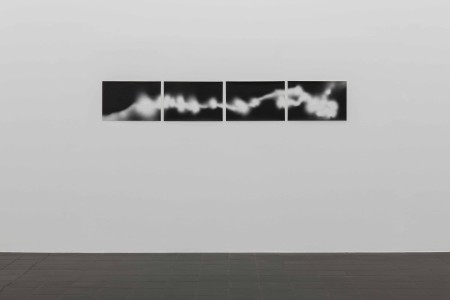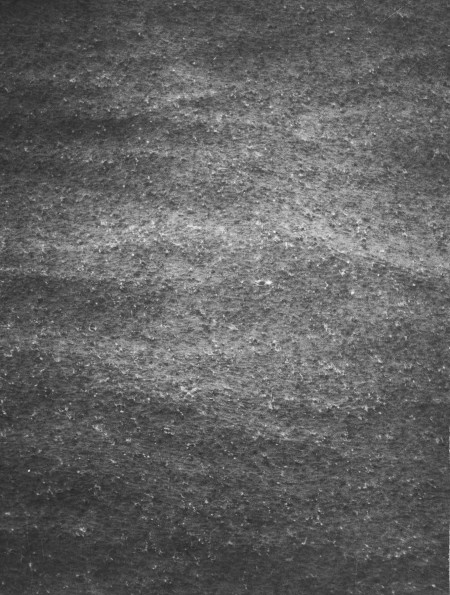Because we are so exposed to and distracted by images in our lives, we become desensitized to one of photography’s chief purposes: to observe. Jochen Lempert’s photography, now on display at the Cincinnati Art Museum in Field Guide: Photographs by Jochen Lempert, presents a captivating retrospective of the artist and biologist’s art, and one that, though at times disjointed, ultimately strives to convince its viewers to reconsider the way we see the world.
In this show, curated by Brian Sholis and Lempert’s first American exhibition, we witness the photographer’s compulsion to catalogue the artifacts of the world. Leaves, magnolias, rain, clouds, animals, skies—the space can feel at times like a preservation ark for the experience of living itself. Tacked up without frames on the museum’s walls, the photographs look as if they could have been just taken out of the darkroom, barely dried. It’s a decision that is jarring at first, but then fits perfectly considering how much Lempert has to say about photography as a medium and the metaphoric role of the darkroom in the everyday.
Perhaps Lempert’s greatest feat is finding invention in photography through a fundamental understanding of the medium’s oldest and most practical purpose, literally practicing the etymology of “photography”—light writing. By portraying the natural process of the art over a desired outcome, the meaning of photography and what constitutes it changes. A glowworm placed upon a strip of unexposed 35mm film traces its slow transit via the larva’s bioluminescent organs in the quadriptych Glowworm, one of Lempert’s experimental pieces. In another, Firefly, a similar conceit has a firefly’s scintillations mapped across a strip of film. In Transmission 1-5, leaves act as film negatives, letting in light to record the specimens’ microscopic texture. These works, referred to as “camera-less” in Sholis’s exhibit guide, might instead challenge the traditional idea of what qualifies as a camera. In Lempert’s images, living things, documented in light, become cameras themselves, vehicles for transfiguration.
A good portion of the small retrospective discloses a fascination with the interconnectedness of nature. Although Lempert worked as a biologist, his field records are not usually clarifications of the world, but instead zoom in on the ambiguities of life, often documenting acts of nature like rain or a swarm of insects so out of context so that they resemble each other, noisy textures of earth. This choice feels a bit transcendentalist, and the photos might deserve multiple visits to truly understand on a more primal level.
In one of the exhibit’s most curiously striking photographs, a commercial jetliner is caught mid-flight between a tangle of jurassic canopy. This, as Sholis explains in the guide—which should be picked up after a first go-around of the space—depicts the “passage of time.” But it also is simply a magnetic document of a single instant, the sepia tone conjuring up a hazy nostalgia for both our future and an era we were never a part of. It gains a collateral poignancy when considering that the Mesozoic period was one that saw the largest mass extinction this world has faced.
Lempert’s attempts to arrest beauty and truth are successful because he frequently undermines our perception of what makes a beautiful photograph. Subjective Photography is an example that lives up to its title. At first glance, the photographs might appear artless—simply smears of white light amid a stark black background—the possibilities for what it could be are endless. When learning that these images are actually a visual record of the photographer’s existence—he set the camera on his chest and a long exposure, coupled with his breathing, let him paint with starlight—allow us to completely reevaluate the photograph. The wisdom of Lempert’s art, or at least its lyrical process, suggests that we not only reevaluate his images, but that we might reinterpret the things we encounter in our day to day lives.
As children, my twin brother and I spent entire days amassing all things natural and displaying them proudly against a crumbling facade that sat opposite our house. It became a kind of museum dedicated to the dull relics littered around the neighborhood: ringed disks of oak, acorns, eucalyptus leaves, dusty objects with petrified fish skeletons burned into the surface. Lempert must have the same need my brother and I once possessed, a desire to catalogue and interrogate the banal wonders of the world. By reclaiming a playful, childlike impulse to observe and archive the natural, Lempert’s almost radical form of photography stands out from all of the other images competing for our attention today. It’s not through visual amplitude, but through a visual whisper, that they reward what they are asking for, which is simply our attention.
—Zack Hatfield

